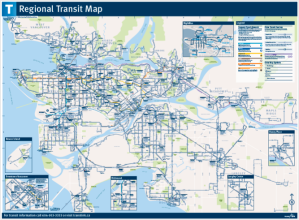Here’s my latest article, available on the Sustainable Collective website here.
We’ve all seen the bus with only two or three people on it and thought… is this really sustainable? Surely it would be more efficient, and cheaper for society, if that bus wasn’t running at all. The simple answer is, when considering greenhouse gas emissions, unless that standard bus has at least 6 people on it then it is less efficient than if all those people were driving cars. Of course, the truth is slightly more complicated than that.
Transit agencies are often chastised for being wasteful by providing service to low-ridership areas and routes, and again, for cutting service in the name of efficiency. Oftentimes it seems like an unwinnable battle. This is a favourite topic of one my favourite transit bloggers, Jarrett Walker of Human Transit: the struggle between providing transit service to a large area versus maximizing transit usage. This is known as coverage versus ridership goals. The conclusion that Walker comes to is that, except in a few extraordinary cases, a combination of these two goals is ultimately what must occur. In truth, most transit agencies eventually come to some kind of balance between the two goals. Together, both the high-ridership and coverage routes make up the network.
Next time you hear a politician claiming the virtues of “running transit like a business”, what they are really extolling is a move towards ridership goals. The end result is almost always service cuts on low performing routes, which are the least profitable. The danger here is that the transit network may be technically more financially-efficient, but without careful consideration critical transit connections may be lost. The whole network also becomes less useful; transit users know this, and may switch to other unsustainable travel modes. Since many transit network users rely on the coverage routes, cutting them will run the risk of losing riders on the busy routes too. These routes are not “mistakes”, but have been carefully selected in order to cover as much urban area as possible as efficiently as possible. Typically these routes will have low frequencies.
What’s important to note is that transit is a system of routes and lines: a network that works together in a mutually beneficial way. A system that is properly designed will be one that has a perfect mix of ridership and coverage routes. So while there is certainly room for improvement on most systems, a few near-empty buses is definitely not a bad thing!

I agree that the men and women tasked with managing and “optimizing” the usefulness of a transit network have a limited series of tools available to them, but we as a culture have plenty that can be done to help bolster transit ecologies. Targeting valuable transit routes for focused development strategies can help breathe life into alternative transportation routes. If densities can increase while providing urban access by transit that is more convenient than transit by car, transit should benefit. We need more focused development efforts like this that pair density increases with transit solutions rather than just trying to expand car infrastructure to accommodate.